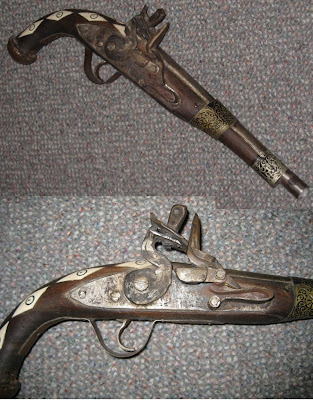
I started this blog to try to discover a little more about this flintlock pistol. I am hoping someone out there will discover this site and be able to identify the piece. Here is all I know about it so far.
My family got it from a neighbor a good number of years ago. He was moving and trying to get rid of some stuff. I don't have any information from him.
There are absolutely no markings on it, other than the inlaid pieces. The lock is incredibly crude compared to the rest of the weapon. It almost seems as though the lock was not made by a gunsmith, but was crudely fashioned, perhaps as a replacement. It any case, the lock was made very roughly. The weapon is functional in that the lock works (it has never been fired with powder, nor do I ever intend to do so). There is a good delay between pulling the trigger and the hammer coming down when dry firing. I suspect this it the result of much dirt and neglect in cleaning, combined with the age of the working parts. The trigger looks to be made in the same rough metal working fashion.
The bands around the stock and barrel are of a very thin metal. They are more ornate than the crudely made lock would suggest. They exhibit a fair amount of wear on the raised parts (the pattern on them is embossed sligtly, and is blackened in the recessed areas).
The stock also exhibits a higher degree of craftsmanship than the lock. It is inlaid with lozenge or diamond shaped white pieces. Each of these has a small black circle in the middle.
Perhaps the most surprising thing is that each of the inlay pieces has, in the center of the small black circle, what appears to be a finishing nail or pin. I'm not an expert in any form, but my thinking is that a finishing nail like the one used would only be in widespread use long after the flintlock technology was eclipsed by more modern firearms. This has also led me to consider that the weapon may be a replica or prop. Or I could be wrong, and such nails or simple pins may have been in use far longer than I realize.
It is far too large to be a toy. If it is a replica, why is the lock so crudely fashioned? The lock does not seem like something mass-produced, it seems to bear the tool marks of its maker (but no markings). And why is the lock so crude, but the inlay not?
